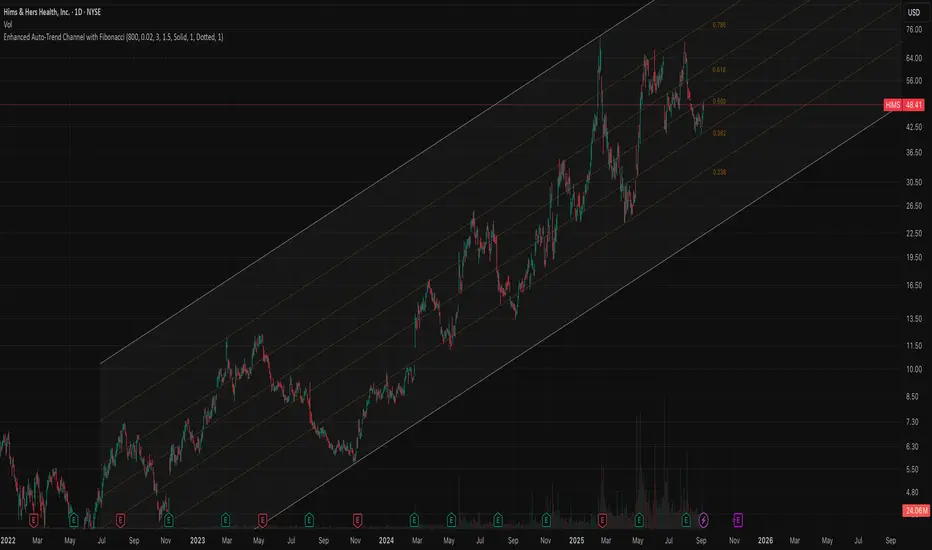OPEN-SOURCE SCRIPT
Auto Trend Channel with Fibonacci

‼️ PLEASE USE WITH LOG CHART
🟠 Overview
This indicator introduces a novel approach to trend channel construction by implementing a touch-based validation system that ensures channels actually function as dynamic support and resistance levels. Unlike traditional linear regression channels that simply fit a mathematical line through price data, this indicator validates channel effectiveness by measuring how frequently price interacts with the boundaries, creating channels that traders can reliably use for entry and exit decisions.
🟠 Core Idea: Touch-Based Channel Validation
The fundamental problem with standard regression channels is that they often create mathematically correct but practically useless boundaries that price rarely respects. This indicator solves this by introducing a dual-scoring optimization system that evaluates each potential channel based on two critical factors:
Trend Correlation (70% weight): Measures how well prices follow the overall trend direction using Pearson correlation coefficient
Boundary Touch Frequency (30% weight): Counts actual instances where price highs touch the upper channel and lows touch the lower channel
This combination ensures the selected channel not only follows the trend but actively serves as support and resistance.
🟠 Trading Applications
Trend Following
Strong Uptrend: Price consistently bounces off lower channel and Fibonacci levels
Strong Downtrend: Price repeatedly fails at upper channel and Fibonacci resistance
Trend Weakening: Price fails to reach channel extremes or breaks through
Entry Strategies
Channel Bounce Entries: Enter long when price touches lower channel with confirmation; short at upper channel touches
Fibonacci Retracement Entries: Use 38.2% or 61.8% levels for pullback entries in trending markets
Breakout Entries: Trade breakouts when price closes beyond channels with increased volume
🟠 Customization Parameters
Automatic/Manual Period: Choose between intelligent auto-detection or fixed lookback period
Touch Sensitivity (0.1%-10%): Defines how close price must be to count as a boundary touch
Minimum Touches (1-10): Filter threshold for channel validation
Adaptive Deviation: Toggle between calculated or manual deviation multipliers
🟠 Overview
This indicator introduces a novel approach to trend channel construction by implementing a touch-based validation system that ensures channels actually function as dynamic support and resistance levels. Unlike traditional linear regression channels that simply fit a mathematical line through price data, this indicator validates channel effectiveness by measuring how frequently price interacts with the boundaries, creating channels that traders can reliably use for entry and exit decisions.
🟠 Core Idea: Touch-Based Channel Validation
The fundamental problem with standard regression channels is that they often create mathematically correct but practically useless boundaries that price rarely respects. This indicator solves this by introducing a dual-scoring optimization system that evaluates each potential channel based on two critical factors:
Trend Correlation (70% weight): Measures how well prices follow the overall trend direction using Pearson correlation coefficient
Boundary Touch Frequency (30% weight): Counts actual instances where price highs touch the upper channel and lows touch the lower channel
This combination ensures the selected channel not only follows the trend but actively serves as support and resistance.
🟠 Trading Applications
Trend Following
Strong Uptrend: Price consistently bounces off lower channel and Fibonacci levels
Strong Downtrend: Price repeatedly fails at upper channel and Fibonacci resistance
Trend Weakening: Price fails to reach channel extremes or breaks through
Entry Strategies
Channel Bounce Entries: Enter long when price touches lower channel with confirmation; short at upper channel touches
Fibonacci Retracement Entries: Use 38.2% or 61.8% levels for pullback entries in trending markets
Breakout Entries: Trade breakouts when price closes beyond channels with increased volume
🟠 Customization Parameters
Automatic/Manual Period: Choose between intelligent auto-detection or fixed lookback period
Touch Sensitivity (0.1%-10%): Defines how close price must be to count as a boundary touch
Minimum Touches (1-10): Filter threshold for channel validation
Adaptive Deviation: Toggle between calculated or manual deviation multipliers
오픈 소스 스크립트
트레이딩뷰의 진정한 정신에 따라, 이 스크립트의 작성자는 이를 오픈소스로 공개하여 트레이더들이 기능을 검토하고 검증할 수 있도록 했습니다. 작성자에게 찬사를 보냅니다! 이 코드는 무료로 사용할 수 있지만, 코드를 재게시하는 경우 하우스 룰이 적용된다는 점을 기억하세요.
면책사항
해당 정보와 게시물은 금융, 투자, 트레이딩 또는 기타 유형의 조언이나 권장 사항으로 간주되지 않으며, 트레이딩뷰에서 제공하거나 보증하는 것이 아닙니다. 자세한 내용은 이용 약관을 참조하세요.
오픈 소스 스크립트
트레이딩뷰의 진정한 정신에 따라, 이 스크립트의 작성자는 이를 오픈소스로 공개하여 트레이더들이 기능을 검토하고 검증할 수 있도록 했습니다. 작성자에게 찬사를 보냅니다! 이 코드는 무료로 사용할 수 있지만, 코드를 재게시하는 경우 하우스 룰이 적용된다는 점을 기억하세요.
면책사항
해당 정보와 게시물은 금융, 투자, 트레이딩 또는 기타 유형의 조언이나 권장 사항으로 간주되지 않으며, 트레이딩뷰에서 제공하거나 보증하는 것이 아닙니다. 자세한 내용은 이용 약관을 참조하세요.